Munson B.R. Fundamentals of Fluid Mechanics
Подождите немного. Документ загружается.

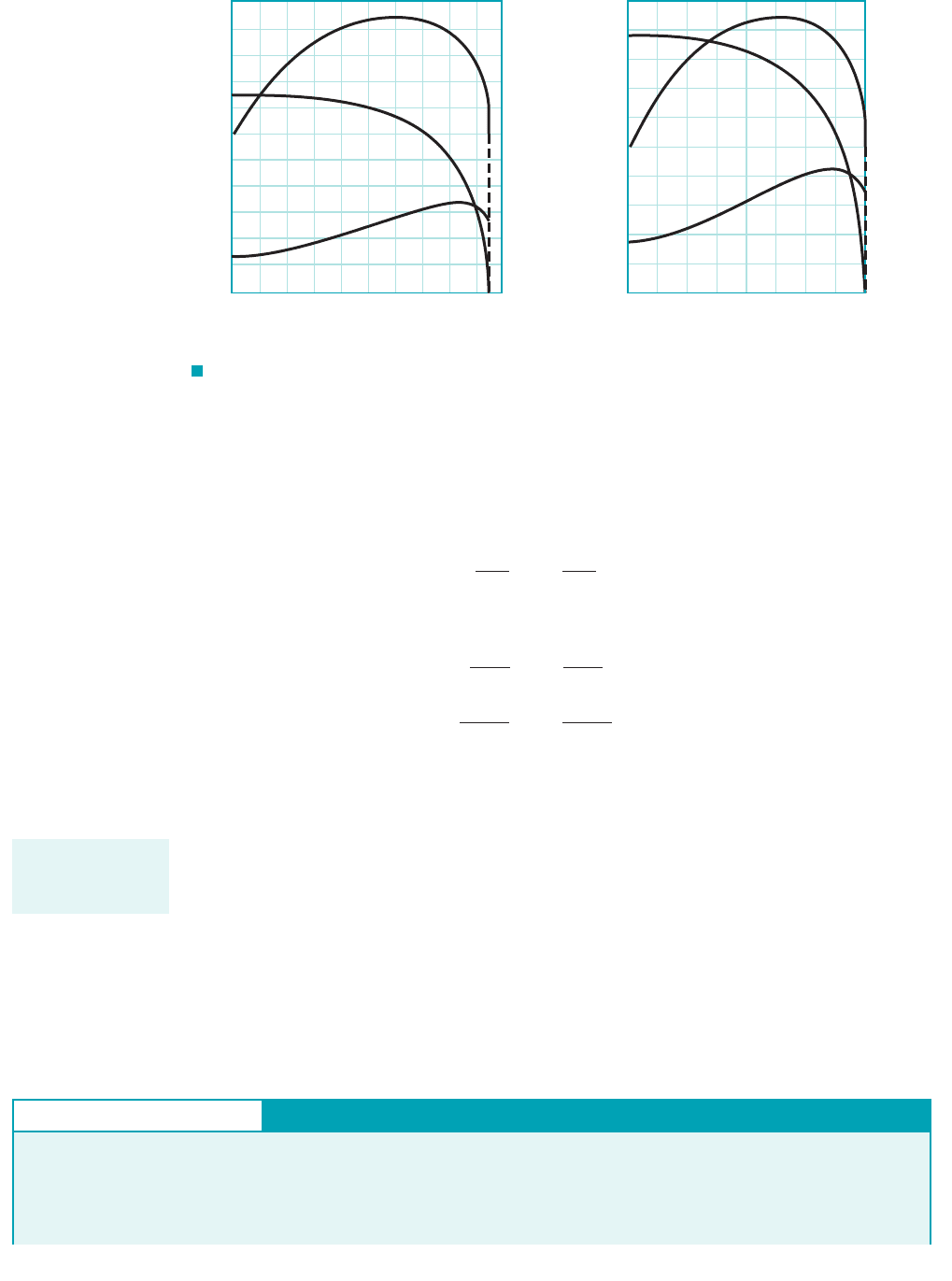
The dimensionless parameter is called the flow coefficient. These three equations
provide the desired similarity relationships among a family of geometrically similar pumps. If
two pumps from the family are operated at the same value of flow coefficient
(12.32)
it then follows that
(12.33)
(12.34)
(12.35)
where the subscripts 1 and 2 refer to any two pumps from the family of geometrically similar
pumps.
With these so-called pump scaling laws it is possible to experimentally determine the per-
formance characteristics of one pump in the laboratory and then use these data to predict the cor-
responding characteristics for other pumps within the family under different operating conditions.
Figure 12.17a shows some typical curves obtained for a centrifugal pump. Figure 12.17b shows
the results plotted in terms of the dimensionless coefficients, and From these curves
the performance of different-sized, geometrically similar pumps can be predicted, as can the effect
of changing speeds on the performance of the pump from which the curves were obtained. It is to
be noted that the efficiency, is related to the other coefficients through the relationship
This follows directly from the definition of h.h C
Q
C
H
C
p
1
.
h,
h.C
Q
, C
H
, C
p
,
h
1
h
2
a
W
#
shaft
rv
3
D
5
b
1
a
W
#
shaft
rv
3
D
5
b
2
a
gh
a
v
2
D
2
b
1
a
gh
a
v
2
D
2
b
2
a
Q
vD
3
b
1
a
Q
vD
3
b
2
C
Q
Q
vD
3
12.5 Dimensionless Parameters and Similarity Laws 667
Pump scaling laws
relate geometrically
similar pumps.
100%
80
60
40
20
0
100
80
60
40
20
0
Brake horsepower Efficiency
0
10
20
30
40
50
60
70
80
0 1000 2000 3000 4000 5000
Capacity, gal/min
(
a)
Head, ft
Horsepower
Head
Efficiency
0
0.05
0.10
0.15
C
H
0.20
0.25
0 0.025 0.050 0.075 0.100
C
Q
(b)
100%
80
60
40
20
0
0.016
0.012
0.008
0.004
0
C
η
C (pump)
C
H
η
P
P
F I G U R E 12.17 Typical performance data for a centrifugal pump: (a) characteristic curves for
a 12-in. centrifugal pump operating at 1000 rpm, (b) dimensionless characteristic curves. (Data from Ref. 8,
used by permission.)
GIVEN An 8-in.-diameter centrifugal pump operating at 1200
rpm is geometrically similar to the 12-in.-diameter pump having
the performance characteristics of Figs. 12.17a and 12.17b while
operating at 1000 rpm. The working fluid is water at 60 °F.
Use of Pump Scaling Laws
E
XAMPLE 12.5
FIND For peak efficiency, predict the discharge, actual head
rise, and shaft horsepower for this smaller pump.
JWCL068_ch12_645-700.qxd 9/25/08 8:42 PM Page 667
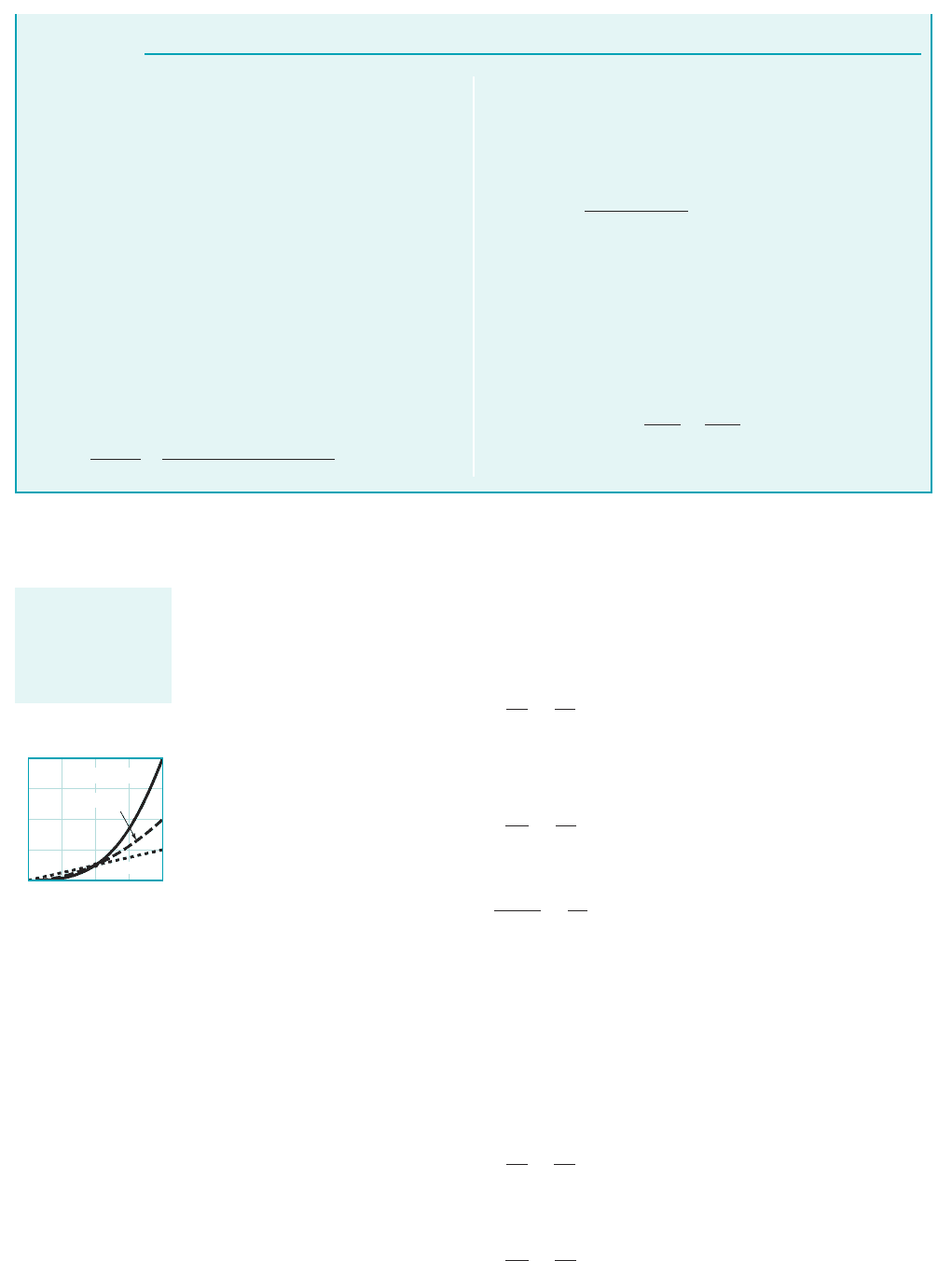
12.5.1 Special Pump Scaling Laws
Two special cases related to pump similitude commonly arise. In the first case we are interested
in how a change in the operating speed, for a given pump, affects pump characteristics. It fol-
lows from Eq. 12.32 that for the same flow coefficient 1and therefore the same efficiency2with
1the same pump2
(12.36)
The subscripts 1 and 2 now refer to the same pump operating at two different speeds at the same
flow coefficient. Also, from Eqs. 12.33 and 12.34 it follows that
(12.37)
and
(12.38)
Thus, for a given pump operating at a given flow coefficient, the flow varies directly with speed,
the head varies as the speed squared, and the power varies as the speed cubed. These effects of an-
gular velocity variation are illustrated in the sketch in the margin. These scaling laws are useful in
estimating the effect of changing pump speed when some data are available from a pump test ob-
tained by operating the pump at a particular speed.
In the second special case we are interested in how a change in the impeller diameter, D, of
a geometrically similar family of pumps, operating at a given speed, affects pump characteristics.
As before, it follows from Eq. 12.32 that for the same flow coefficient with
(12.39)
Similarly, from Eqs. 12.33 and 12.34
(12.40)
h
a1
h
a2
⫽
D
2
1
D
2
2
Q
1
Q
2
⫽
D
1
3
D
2
3
v
1
⫽ v
2
W
#
shaft1
W
#
shaft2
⫽
v
3
1
v
3
2
h
a1
h
a2
⫽
v
1
2
v
2
2
Q
1
Q
2
⫽
v
1
v
2
D
1
⫽ D
2
v,
668 Chapter 12 ■ Turbomachines
S
OLUTION
As is indicated by Eq. 12.31, for a given efficiency the flow coef-
ficient has the same value for a given family of pumps. From Fig.
12.17b we see that at peak efficiency Thus, for the
8-in. pump
(Ans)
or in terms of gpm
(Ans)
The actual head rise and the shaft horsepower can be deter-
mined in a similar manner since at peak efficiency
and so that with
(Ans)
h
a
⫽
C
H
v
2
D
2
g
⫽
10.1921126 rad
Ⲑ
s2
2
18
Ⲑ
12 ft2
2
32.2 ft
Ⲑ
s
2
⫽ 41.6 ft
12p rad
Ⲑ
rev2⫽ 126 rad
Ⲑ
s
v ⫽ 1200 rev
Ⲑ
min11 min
Ⲑ
60 s2C
p
⫽ 0.014,
C
H
⫽ 0.19
⫽ 1046 gpm
Q ⫽ 12.33 ft
3
Ⲑ
s217.48 gal
Ⲑ
ft
3
2160 s
Ⲑ
min2
Q ⫽ 2.33 ft
3
Ⲑ
s
⫽ 10.0625211200
Ⲑ
60 rev
Ⲑ
s212p rad
Ⲑ
rev218
Ⲑ
12 ft2
3
Q ⫽ C
Q
vD
3
C
Q
⫽ 0.0625.
and
(Ans)
COMMENT This last result gives the shaft horsepower,
which is the power supplied to the pump shaft. The power actu-
ally gained by the fluid is equal to which in this example is
Thus, the efficiency, is
which checks with the efficiency curve of Fig. 12.17b.
h ⫽
p
f
W
#
shaft
⫽
6050
7150
⫽ 85%
h,
p
f
⫽ gQh
a
⫽ 162.4 lb
Ⲑ
ft
3
212.33 ft
3
Ⲑ
s2141.6 ft2⫽ 6050 ft
#
lb
Ⲑ
s
gQh
a
,
W
#
shaft
⫽
7150 ft
#
lb
Ⲑ
s
550 ft
#
lb
Ⲑ
s
Ⲑ
hp
⫽ 13.0 hp
⫽ 7150 ft
#
lb
Ⲑ
s
⫽ 10.014211.94 slugs
Ⲑ
ft
3
21126 rad
Ⲑ
s2
3
18
Ⲑ
12 ft2
5
W
#
shaft
⫽ C
p
rv
3
D
5
8
6
4
2
0
0 0.5 1 1.5 2
⋅ ⋅
W
shaft1
/W
s
haft2
w
1
/w
2
h
a1
/h
a2
Q
1
/Q
2
Effects of changes
in pump operating
speed and impeller
diameter are often
of interest.
JWCL068_ch12_645-700.qxd 9/25/08 8:44 PM Page 668

and
(12.41)
Thus, for a family of geometrically similar pumps operating at a given speed and the same flow
coefficient, the flow varies as the diameter cubed, the head varies as the diameter squared, and the
power varies as the diameter raised to the fifth power. These strong effects of diameter variation
are illustrated in the sketch in the margin. These scaling relationships are based on the condition
that, as the impeller diameter is changed, all other important geometric variables are properly scaled
to maintain geometric similarity. This type of geometric scaling is not always possible due to prac-
tical difficulties associated with manufacturing the pumps. It is common practice for manufactur-
ers to put impellers of different diameters in the same pump casing. In this case, complete geometric
similarity is not maintained, and the scaling relationships expressed in Eqs. 12.39, 12.40, and 12.41
will not, in general, be valid. However, experience has shown that if the impeller diameter change
is not too large, less than about 20%, these scaling relationships can still be used to estimate the
effect of a change in the impeller diameter. The pump similarity laws expressed by Eqs. 12.36
through 12.41 are sometimes referred to as the pump affinity laws.
The effects of viscosity and surface roughness have been neglected in the foregoing similar-
ity relationships. However, it has been found that as the pump size decreases these effects more
significantly influence efficiency because of smaller clearances and blade size. An approximate,
empirical relationship to estimate the influence of diminishing size on efficiency is 1Ref. 92
(12.42)
In general, it is to be expected that the similarity laws will not be very accurate if tests on a model
pump with water are used to predict the performance of a prototype pump with a highly viscous
fluid, such as oil, because at the much smaller Reynolds number associated with the oil flow, the
fluid physics involved is different from the higher Reynolds number flow associated with water.
12.5.2 Specific Speed
A useful pi term can be obtained by eliminating diameter D between the flow coefficient and the
head rise coefficient. This is accomplished by raising the flow coefficient to an appropriate expo-
nent and dividing this result by the head coefficient raised to another appropriate exponent
so that
(12.43)
The dimensionless parameter is called the specific speed. Specific speed varies with flow coef-
ficient just as the other coefficients and efficiency discussed earlier do. However, for any pump it
is customary to specify a value of specific speed at the flow coefficient corresponding to peak ef-
ficiency only. For pumps with low Q and high the specific speed is low compared to a pump
with high Q and low Centrifugal pumps typically are low-capacity, high-head pumps, and there-
fore have low specific speeds.
Specific speed as defined by Eq. 12.43 is dimensionless, and therefore independent of the sys-
tem of units used in its evaluation as long as a consistent unit system is used. However, in the United
States a modified, dimensional form of specific speed, is commonly used, where
(12.44)
In this case is said to be expressed in U.S. customary units. Typical values of are in the
range for centrifugal pumps. Both and have the same physical mean-
ing, but their magnitudes will differ by a constant conversion factor when in
Eq. 12.43 is expressed in rad兾s.
Each family or class of pumps has a particular range of values of specific speed associated with
it. Thus, pumps that have low-capacity, high-head characteristics will have specific speeds that are
v1N
sd
2733 N
s
2
N
sd
N
s
500 6 N
sd
6 4000
N
sd
N
sd
N
sd
v1rpm21Q1gpm2
3h
a
1ft24
3
4
N
sd
,
h
a
.
h
a
,
N
s
1Q
vD
3
2
1
2
1gh
a
v
2
D
2
2
3
4
v1Q
1gh
a
2
3
4
N
s
13
42
11
22
1 h
2
1 h
1
⬇ a
D
1
D
2
b
1
5
W
#
shaft1
W
#
shaft2
D
5
1
D
5
2
12.5 Dimensionless Parameters and Similarity Laws 669
8
6
4
2
0
0 0.5 1 1.5 2
⋅ ⋅
W
shaft1
/W
s
haft2
h
a1
/h
a2
Q
1
/Q
2
D
1
/D
2
Pump affinity laws
relate the same
pump at different
speeds or geometri-
cally similar pumps
at the same speed.
JWCL068_ch12_645-700.qxd 9/25/08 8:44 PM Page 669
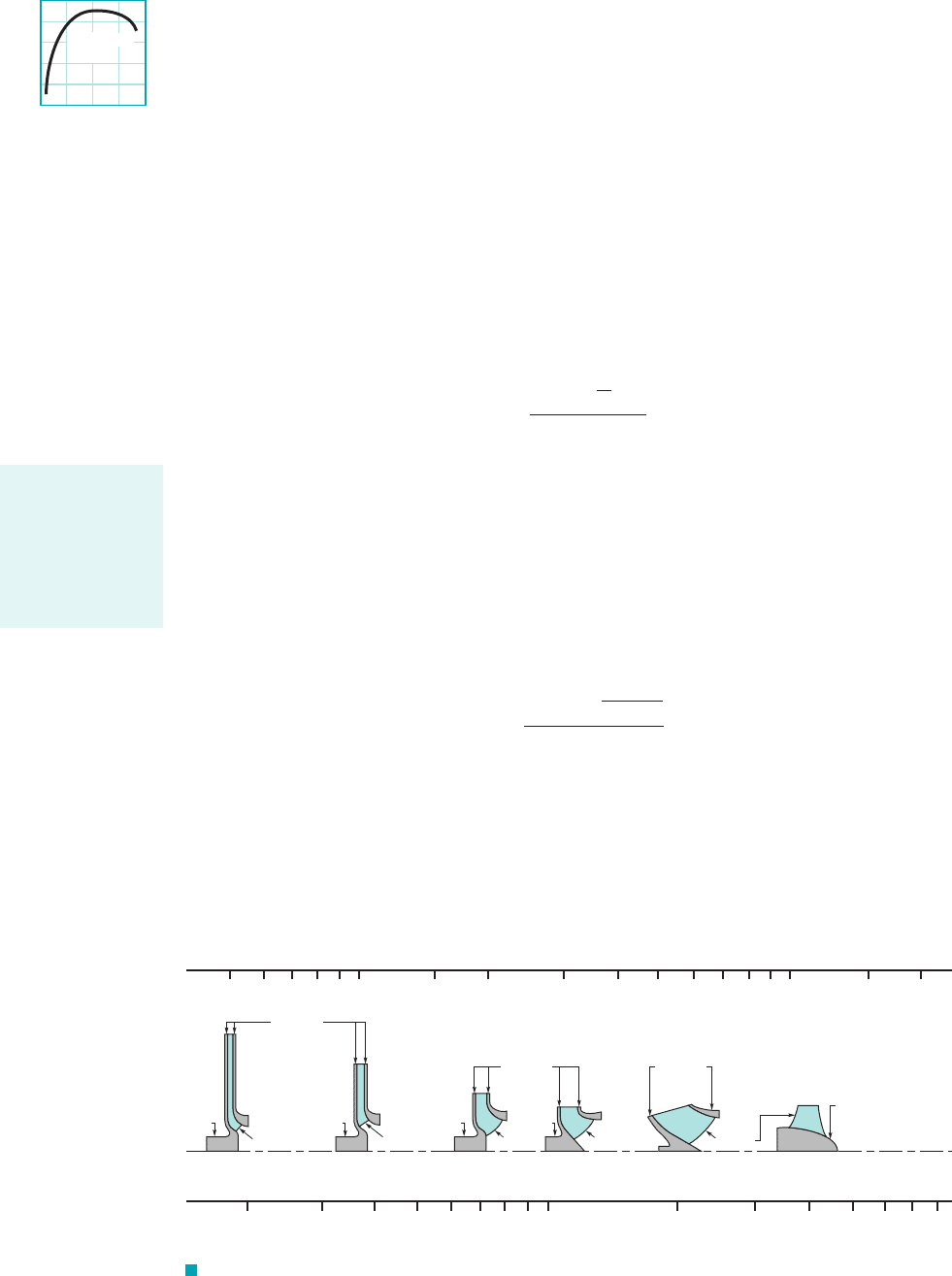
smaller than pumps that have high-capacity, low-head characteristics. The concept of specific speed
is very useful to engineers and designers, since if the required head, flowrate, and speed are speci-
fied, it is possible to select an appropriate 1most efficient2type of pump for a particular application.
For example, as shown by the figure in the margin, as the specific speed, increases beyond about
2000 the peak efficiency, of the purely radial-flow centrifugal pump starts to fall off, and other
types of more efficient pump design are preferred. In addition to the centrifugal pump, the axial-flow
pump is widely used. As discussed in Section 12.6, in an axial-flow pump the direction of flow is
primarily parallel to the rotating shaft rather than radial as in the centrifugal pump. Axial-flow pumps
are essentially high-capacity, low-head pumps, and therefore have large specific speeds
compared to centrifugal pumps. Mixed-flow pumps combine features of both radial-flow and axial-
flow pumps and have intermediate values of specific speed. Figure 12.18 illustrates how the specific
speed changes as the configuration of the pump changes from centrifugal or radial to axial.
12.5.3 Suction Specific Speed
With an analysis similar to that used to obtain the specific speed pi term, the suction specific speed,
can be expressed as
(12.45)
where in Eq. 12.43 has been replaced by the required net positive suction head This
dimensionless parameter is useful in determining the required operating conditions on the suction
side of the pump. As was true for the specific speed, the value for commonly used is for
peak efficiency. For a family of geometrically similar pumps, should have a fixed value. If this
value is known, then the can be estimated for other pumps within the same family oper-
ating at different values of and Q.
As noted for the suction specific speed as defined by Eq. 12.45 is also dimensionless,
and the value for is independent of the system of units used. However, as was the case for spe-
cific speed, in the United States a modified dimensional form for the suction specific speed, des-
ignated as is commonly used, where
(12.46)
For double-suction pumps the discharge, Q, in Eq. 12.46 is one-half the total discharge.
Typical values for fall in the range of 7000 to 12,000 1Ref. 112. If is specified, Eq. 12.46
can be used to estimate the for a given set of operating conditions. However, this calculation
would generally only provide an approximate value for the and the actual determination of
the for a particular pump should be made through a direct measurement whenever possible.
Note that with expressed in rad兾s in Eq. 12.45.vS
sd
⫽ 2733 S
s
,
NPSH
R
NPSH
R
,
NPSH
R
S
sd
S
sd
S
sd
⫽
v1rpm21Q1gpm2
3NPSH
R
1ft24
3
Ⲑ
4
S
sd
,
S
s
N
s
,
v
NPSH
R
S
s
S
s
N
s
,
1NPSH
R
2.h
a
S
s
⫽
v1Q
3g1NPSH
R
24
3
Ⲑ
4
S
s
,
1N
sd
7 90002
h
N
sd
,
670 Chapter 12 ■ Turbomachines
80
60
h
40
2000
N
sd
4000
Radial flow
pump
500
600
700
800
900
1000
1500
2000
3000
4000
5000
6000
7000
8000
9000
10000
15000
20000
0.2
0.3
0.4
0.5
0.6
0.7
0.8
0.9
1.0
2.0
3.0
4.0
5.0
6.0
7.0
8.0
Radial flow
Specific speed, N
s
Specific speed, N
sd
Mixed flow Axial flow
Axis of
rotation
Vanes
Hub
Impeller
shrouds
Vanes
Hub
Vanes
Hub
Vanes
Hub
Impeller
shrouds
Vanes
Impeller
shrouds
Impeller
hub
F I G U R E 12.18 Variation in specific speed at maximum efficiency with type of pump. (Adapted
from Ref. 10, used with permission.)
Specific speed may
be used to approxi-
mate what general
pump geometry (ax-
ial, mixed or radial)
to use for maximum
efficiency.
JWCL068_ch12_645-700.qxd 9/25/08 8:44 PM Page 670

12.6 Axial-Flow and Mixed-Flow Pumps 671
As noted previously, centrifugal pumps are radial-flow machines that operate most efficiently for
applications requiring high heads at relatively low flowrates. This head–flowrate combination typ-
ically yields specific speeds that are less than approximately 4000. For many applications,
such as those associated with drainage and irrigation, high flowrates at low heads are required
and centrifugal pumps are not suitable. In this case, axial-flow pumps are commonly used. This
type of pump consists essentially of a propeller confined within a cylindrical casing. Axial-flow
pumps are often called propeller pumps. For this type of pump the flow is primarily in the axial
direction 1parallel to the axis of rotation of the shaft2, as opposed to the radial flow found in the
centrifugal pump. Whereas the head developed by a centrifugal pump includes a contribution due
to centrifugal action, the head developed by an axial-flow pump is due primarily to the tangen-
tial force exerted by the rotor blades on the fluid. A schematic of an axial-flow pump arranged
for vertical operation is shown in Fig. 12.19. The rotor is connected to a motor through a shaft,
and as it rotates 1usually at a relatively high speed2the fluid is sucked in through the inlet. Typ-
ically the fluid discharges through a row of fixed stator 1guide2vanes used to straighten the flow
leaving the rotor. Some axial-flow pumps also have inlet guide vanes upstream of the rotor row,
and some are multistage in which pairs 1stages2of rotating blades 1rotor blades2and fixed vanes
1stator blades2are arranged in series. Axial-flow pumps usually have specific speeds in ex-
cess of 9000.
The definitions and broad concepts that were developed for centrifugal pumps are also ap-
plicable to axial-flow pumps. The actual flow characteristics, however, are quite different. In Fig.
12.20 typical head, power, and efficiency characteristics are compared for a centrifugal pump and
an axial-flow pump. It is noted that at design capacity 1maximum efficiency2the head and brake
horsepower are the same for the two pumps selected. But as the flowrate decreases, the power in-
put to the centrifugal pump falls to 180 hp at shutoff, whereas for the axial-flow pump the power
input increases to 520 hp at shutoff. This characteristic of the axial-flow pump can cause overload-
ing of the drive motor if the flowrate is reduced significantly from the design capacity. It is also
noted that the head curve for the axial-flow pump is much steeper than that for the centrifugal
pump. Thus, with axial-flow pumps there will be a large change in head with a small change in
the flowrate, whereas for the centrifugal pump, with its relatively flat head curve, there will be
only a small change in head with large changes in the flowrate. It is further observed from Fig.
12.20 that, except at design capacity, the efficiency of the axial-flow pump is lower than that of
the centrifugal pump. To improve operating characteristics, some axial-flow pumps are constructed
with adjustable blades.
For applications requiring specific speeds intermediate to those for centrifugal and axial-flow
pumps, mixed-flow pumps have been developed that operate efficiently in the specific speed range
As the name implies, the flow in a mixed-flow pump has both a radial and an
axial component. Figure 12.21 shows some typical data for centrifugal, mixed-flow, and axial-flow
pumps, each operating with the same flowrate. These data indicate that as we proceed from the
centrifugal pump to the mixed-flow pump to the axial-flow pump, the specific speed increases, the
4000 6 N
sd
6 9000.
1N
sd
2
1N
sd
2
12.6 Axial-Flow and Mixed-Flow Pumps
Inlet
Discharge
Rotor blades
Fixed stator blades
Drive shaft
Shaft to motor
F I G U R E 12.19 Schematic
diagram of an axial-flow pump arranged
for vertical operation.
Axial-flow pumps
often have alternat-
ing rows of stator
blades and rotor
blades.
JWCL068_ch12_645-700.qxd 9/25/08 8:44 PM Page 671

head decreases, the speed increases, the impeller diameter decreases, and the eye diameter increases.
These general trends are commonly found when these three types of pumps are compared.
The dimensionless parameters and scaling relationships developed in the previous sections
apply to all three types of pumps—centrifugal, mixed-flow, and axial-flow—since the dimensional
analysis used is not restricted to a particular type of pump. Additional information about pumps
can be found in Refs. 4, 7, 9, 12, and 13.
672 Chapter 12 ■ Turbomachines
Brake horsepower
Efficiency
0 10 20 30 40 50 60
0
20
40
60
80
100
200
300
400
500
Capacity, 1000 gal/min
Percent Efficiency
10
20
30
40
50
60
Brake Horsepower
Head, ft
Head
Centrifugal pump
Axial-flow pump
F I G U R E 12.20 Comparison of
performance characteristics for a centrifugal pump
and an axial-flow pump, each rated 42,000 gal兾min
at a 17-ft head. (Data from Ref. 12, used with per-
mission.)
Fluids in the News
Mechanical heart assist devicesAs with any pump, the human
heart can suffer various malfunctions and problems during its
useful life. Recent developments in artificial heart technology
may be able to provide help to those whose pumps have broken
down beyond repair. One of the more promising techniques is
use of a left-ventricular assist device (LVAD), which supple-
ments a diseased heart. Rather than replacing a diseased heart,
an LVAD pump is implanted alongside the heart and works in
parallel with the cardiovascular system to assist the pumping
function of the heart’s left ventricle. (The left ventricle supplies
oxygenated blood to the entire body and performs about 80% of
the heart’s work.) Some LVADs are centrifugal or axial flow
pumps that provide a continuous flow of blood. The continuous
flow may take some adjustment on the part of patients, who do
not hear a pulse or a heartbeat. Despite advances in artificial
heart technology, it is probably still several years before fully
implantable, quiet, and reliable devices will be considered for
widespread use.
A B CD
Runner
vanes
Runner
vanes
Type Centrifugal Mixed flow Axial flow
N
sd
Gal/ min
Head, ft
Rpm
D, in.
D
eye
/D
Centrifugal
1,250
2,400
70
870
19
0.5
2,200
2,400
48
1,160
12
0.7
6,200
2,400
33
1,750
10
0.9
13,500
2,400
20
2,600
7
1.0
Eye
Diameter D
F I G U R E 12.21 Comparison of different types of impellers. Specific speed for
centrifugal pumps based on single suction and identical flowrate. (Adapted from Ref. 12, used with
permission.)
JWCL068_ch12_645-700.qxd 9/25/08 8:44 PM Page 672

12.8 Turbines 673
Fluids in the News
Hi-tech ceiling fans Energy savings of up to 25% can be real-
ized if thermostats in air-conditioned homes are raised by a few
degrees. This can be accomplished by using ceiling fans and
taking advantage of the increased sensible cooling brought on
by air moving over skin. If the energy used to run the fans can
be reduced, additional energy savings can be realized. Most
ceiling fans use flat, fixed pitch, nonaerodynamic blades with
uniform chord length. Because the tip of a paddle moves
through air faster than its root does, airflow over such fan blades
is lowest near the hub and highest at the tip. By making the fan
blade more propeller-like, it is possible to have a more uniform,
efficient distribution. However, since ceiling fans are restricted
by law to operate at less than 200 rpm, ordinary airplane pro-
peller design is not appropriate. After considerable design ef-
fort, a highly efficient ceiling fan capable of delivering the same
airflow as the conventional design with only half the power has
been successfully developed and marketed. The fan blades are
based on the slowly turning prop used in the Gossamer
Albatross, the human-powered aircraft that flew across the Eng-
lish Channel in 1979. (See Problem 12.58.)
When the fluid to be moved is air, or some other gas or vapor, fans are commonly used. Types of
fans vary from the small fan used for cooling desktop computers to large fans used in many indus-
trial applications such as ventilating of large buildings. Fans typically operate at relatively low ro-
tation speeds and are capable of moving large volumes of gas. Although the fluid of interest is a
gas, the change in gas density through the fan does not usually exceed 7%, which for air represents
a change in pressure of only about 1 psi 1Ref. 142. Thus, in dealing with fans, the gas density is
treated as a constant, and the flow analysis is based on incompressible flow concepts. Because of
the low pressure rise involved, fans are often constructed of lightweight sheet metal. Fans are also
called blowers, boosters, and exhausters depending on the location within the system; that is, blow-
ers are located at the system entrance, exhausters are at the system exit, and boosters are located at
some intermediate position within the system. Turbomachines used to produce larger changes in gas
density and pressure than possible with fans are called compressors 1see Section 12.9.12.
As is the case for pumps, fan designs include centrifugal 1radial-flow2fans, as well as
mixed-flow and axial-flow 1propeller2fans, and the analysis of fan performance closely follows
that previously described for pumps. The shapes of typical performance curves for centrifugal
and axial-flow fans are quite similar to those shown in Fig. 12.20 for centrifugal and axial-flow
pumps. However, fan head-rise data are often given in terms of pressure rise, either static or to-
tal, rather than the more conventional head rise commonly used for pumps.
Scaling relationships for fans are the same as those developed for pumps, that is, Eqs.
12.32 through 12.35 apply to fans as well as pumps. As noted above, for fans it is common to
replace the head, in Eq. 12.33 with pressure head, so that Eq. 12.33 becomes
(12.47)
where, as before, the subscripts 1 and 2 refer to any two fans from the family of geometrically
similar fans. Equations 12.47, 12.32 and 12.34, are called the fan laws and can be used to scale
performance characteristics between members of a family of geometrically similar fans. Additional
information about fans can be found in Refs. 14–17.
a
p
a
rv
2
D
2
b
1
⫽ a
p
a
rv
2
D
2
b
2
p
a
Ⲑ
rg,h
a
,
12.7 Fans
As discussed in Section 12.2, turbines are devices that extract energy from a flowing fluid. The
geometry of turbines is such that the fluid exerts a torque on the rotor in the direction of its rota-
tion. The shaft power generated is available to drive generators or other devices.
In the following sections we discuss mainly the operation of hydraulic turbines 1those for
which the working fluid is water2and to a lesser extent gas and steam turbines 1those for which
the density of the working fluid may be much different at the inlet than at the outlet2.
Although there are numerous ingenious hydraulic turbine designs, most of these turbines can
be classified into two basic types—impulse turbines and reaction turbines. 1Reaction is related to
12.8 Turbines
Fans are used to
pump air and other
gases and vapors.
JWCL068_ch12_645-700.qxd 9/25/08 8:44 PM Page 673
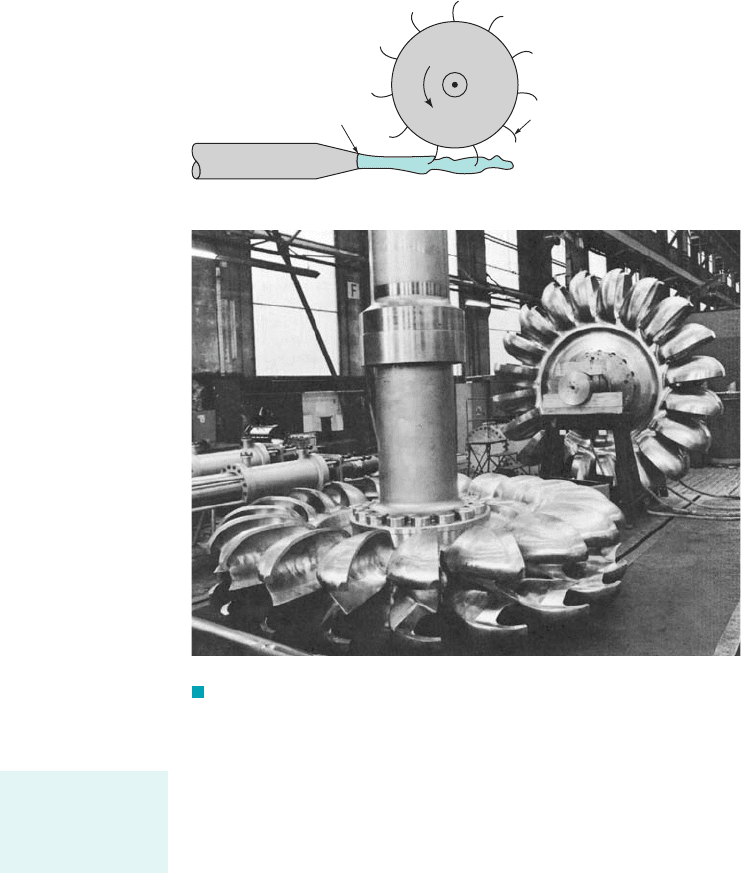
the ratio of static pressure drop that occurs across the rotor to static pressure drop across the turbine
stage, with larger rotor pressure drop corresponding to larger reaction.2For hydraulic impulse tur-
bines, the pressure drop across the rotor is zero; all of the pressure drop across the turbine stage oc-
curs in the nozzle row. The Pelton wheel shown in Fig. 12.22 is a classical example of an impulse
turbine. In these machines the total head of the incoming fluid 1the sum of the pressure head, veloc-
ity head, and elevation head2is converted into a large velocity head at the exit of the supply nozzle
1or nozzles if a multiple nozzle configuration is used2. Both the pressure drop across the bucket 1blade2
and the change in relative speed 1i.e., fluid speed relative to the moving bucket2of the fluid across
the bucket are negligible. The space surrounding the rotor is not completely filled with fluid. It is the
impulse of the individual jets of fluid striking the buckets that generates the torque.
For reaction turbines, on the other hand, the rotor is surrounded by a casing 1or volute2, which
is completely filled with the working fluid. There is both a pressure drop and a fluid relative speed
change across the rotor. As shown for the radial-inflow turbine in Fig 12.23, guide vanes act as noz-
zles to accelerate the flow and turn it in the appropriate direction as the fluid enters the rotor. Thus,
part of the pressure drop occurs across the guide vanes and part occurs across the rotor. In many re-
spects the operation of a reaction turbine is similar to that of a pump “flowing backward,” although
such oversimplification can be quite misleading.
Both impulse and reaction turbines can be analyzed using the moment-of-momentum prin-
ciples discussed in Section 12.3. In general, impulse turbines are high-head, low-flowrate devices,
while reaction turbines are low-head, high-flowrate devices.
12.8.1 Impulse Turbines
Although there are various types of impulse turbine designs, perhaps the easiest to understand is the
Pelton wheel 1see Fig. 12.242. Lester Pelton 11829–19082, an American mining engineer during the
674 Chapter 12 ■ Turbomachines
Rotor
Bucket
Nozzle
(a)
(b)
F I G U R E 12.22 (a) Schematic diagram of a Pelton wheel turbine,
(b) photograph of a Pelton wheel turbine. (Courtesy of Voith Hydro, York, PA.)
The two basic types
of hydraulic tur-
bines are impulse
and reaction.
JWCL068_ch12_645-700.qxd 9/25/08 8:44 PM Page 674
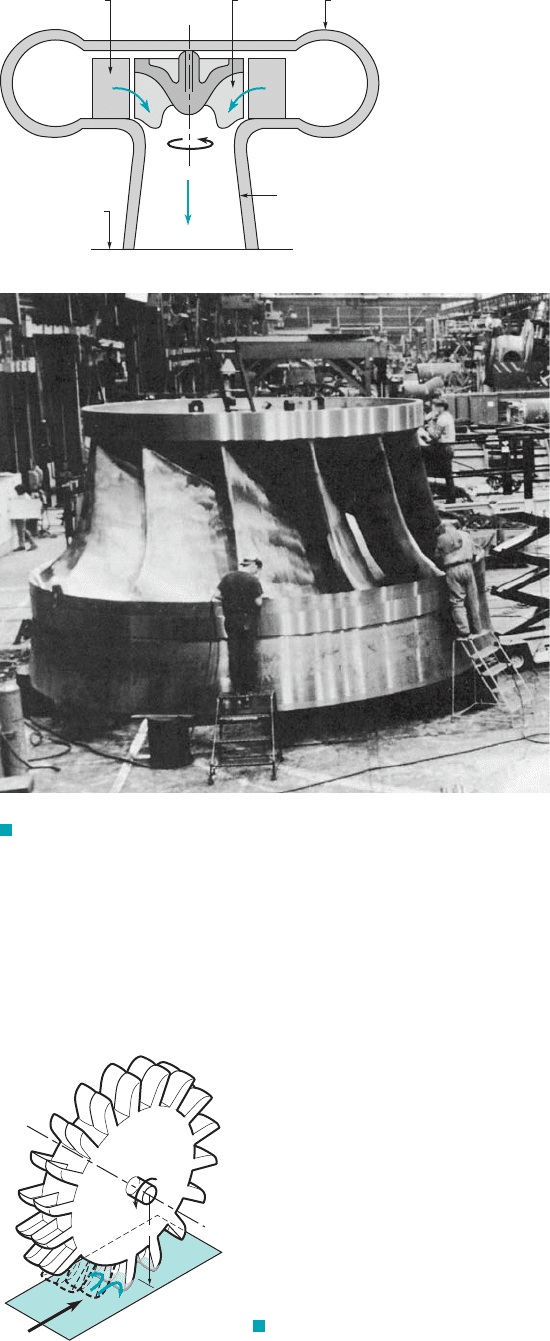
California gold-mining days, is responsible for many of the still-used features of this type of tur-
bine. It is most efficient when operated with a large head 1for example, a water source from a lake
located significantly above the turbine nozzle2, which is converted into a relatively large velocity at
the exit of the nozzle. Among the many design considerations for such a turbine are the head loss
that occurs in the pipe 1the penstock2transporting the water to the turbine, the design of the nozzle,
and the design of the buckets on the rotor.
12.8 Turbines 675
(b)
Draft tube
Tail race
Adjustable
guide vanes
Rotor
vanes
Casing
(a)
F I G U R E 12.23 (a) Schematic diagram of a reaction turbine,
(b) photograph of a reaction turbine. (Courtesy of Voith Hydro, York, PA.)
a
a
b
r
m
V
1
b
F I G U R E 12.24 Details of
Pelton wheel turbine bucket.
JWCL068_ch12_645-700.qxd 9/30/08 8:38 AM Page 675
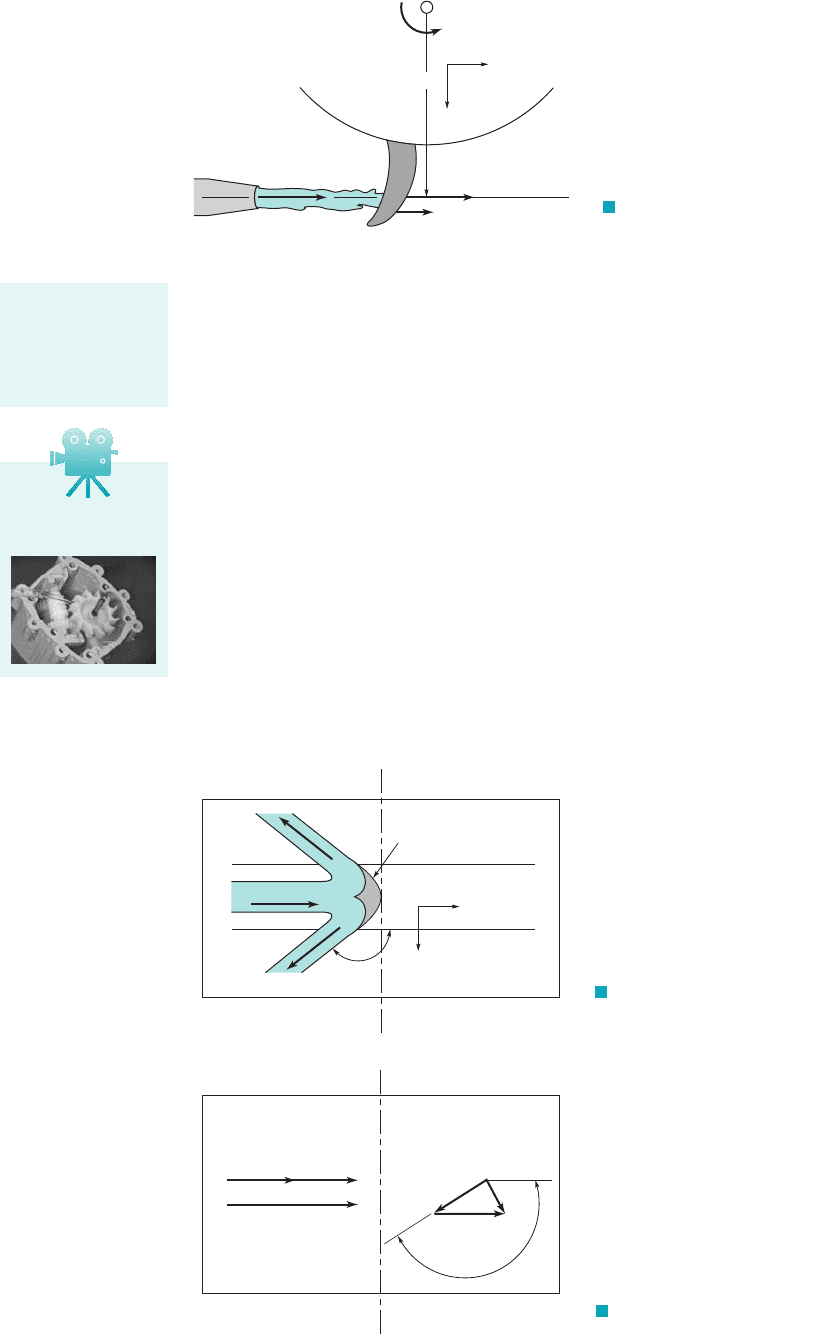
As shown in Fig. 12.24, a high-speed jet of water strikes the Pelton wheel buckets and is de-
flected. The water enters and leaves the control volume surrounding the wheel as free jets 1atmos-
pheric pressure2. In addition, a person riding on the bucket would note that the speed of the water
does not change as it slides across the buckets 1assuming viscous effects are negligible2. That is, the
magnitude of the relative velocity does not change, but its direction does. The change in direction of
the velocity of the fluid jet causes a torque on the rotor, resulting in a power output from the turbine.
Design of the optimum, complex shape of the buckets to obtain maximum power output
is a very difficult matter. Ideally, the fluid enters and leaves the control volume shown in Fig.
12.25 with no radial component of velocity. 1In practice there often is a small but negligible ra-
dial component.2In addition, the buckets would ideally turn the relative velocity vector through
a turn, but physical constraints dictate that the angle of the exit edge of the blade, is less
than Thus, the fluid leaves with an axial component of velocity as shown in Fig. 12.26.
The inlet and exit velocity triangles at the arithmetic mean radius, are assumed to be as
shown in Fig. 12.27. To calculate the torque and power, we must know the tangential components
of the absolute velocities at the inlet and exit. 1Recall from the discussion in Section 12.3 that nei-
ther the radial nor the axial components of velocity enter into the torque or power equations.2From
Fig. 12.27 we see that
(12.48)V
u1
⫽ V
1
⫽ W
1
⫹ U
r
m
,
180°.
b,180°
676 Chapter 12 ■ Turbomachines
Tangential
V
1
V
2
U
b
ω
Radial
r
m
a
F I G U R E 12.25 Ideal fluid
velocities for a Pelton wheel turbine.
Pelton wheel tur-
bines operate most
efficiently with a
larger head and
lower flowrates.
V12.3 Pelton wheel
lawn sprinkler
a
a
b
b
W
1
β
U
V
1
W
1
= W
2
U
V
2
F I G U R E 12.27 Inlet and exit
velocity triangles for a Pelton wheel turbine.
a
a
b
b
W
1
= V
1
– U
Blade cross section
W
2
= W
1
= V
1
– U
β
Tangential
Axial
F I G U R E 12.26 Flow as viewed
by an observer riding on the Pelton wheel—relative
velocities.
JWCL068_ch12_645-700.qxd 9/25/08 8:44 PM Page 676
